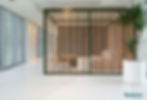Brass Divider Strips in Terrazzo
- bradhedges
- Dec 15, 2020
- 4 min read
Updated: Oct 2

Brass and gold-colored metals are very trendy at the moment, and rightfully so. It's a really good look. In today's post, we’ll discuss the use of brass divider strips with epoxy terrazzo.

There are a few things to know about the brass material. First, brass is a premium material and costs approx 4-5x the cost of aluminum divider strips which are typically the standard for terrazzo. The standard gauges are available in 1/16”, ⅛” and ¼” however custom strips are available as wide as you prefer, just keep in mind that the cost increases as you have a heavier gauge because you are using more brass.

Brass is an alloy composed of approx 70% copper and 30% zinc. This surface coating may be damaged during the handling and installation of terrazzo floors.
One important concern with regard to compromising the appearance of brass is the possibility of copper salt formation (or Bluing). The threat of bluing occurs when a brass strip or inlay is exposed to oxygen and one of the following elements: excessive quantities of water, unreacted amine (Part B Hardener), strong alkaline solutions, or a combination of any or all these three solutions.

If copper salt formation occurs, the brass strip or inlay needs to be cleaned immediately to avoid bluing; however, the best solution to bluing is to avoid circumstances that encourage copper salt formation. By simply following the guidelines referenced below, the threat of copper salt formation is drastically reduced.

Installation Guidelines:
Have the terrazzo contractor coat the sides of the brass divider strips with the same binder resin prior to setting them. This will help seal and eliminate any issue.
1. Shot blasting is the recommended substrate preparation method. Acid etching introduces an excessive quantity of water to the substrate. Excessive quantities of water contribute to the formation of copper salt.
2. Wait until the HVAC system is operational before installing terrazzo flooring systems. A temperature controlled environment with reduced humidity will decrease condensation which contributes toward copper salt formation.
3.Thoroughly mix Part B Hardener with Part A Resin. An evenly mixed solution avoids excessive concentrations of Part B Hardener throughout the epoxy system. (Immediately clean any spills of Part B Hardener which occur near brass strips. This helps to reduce unreacted amines which contribute toward copper salt formation.)
4.Ensure that aggregates are sufficiently dry before they are added to epoxy mixture (This should already be a standard practice for proper epoxy terrazzo preparation.) Also be sure to thoroughly mix aggregate with epoxy to promote complete blending of material. This helps to limit the water introduced to the mixture and continues to reduce concentrations of unreacted amines.
5. When pouring your epoxy mixture, be sure that there are no voids near your brass strip or inlays. Be sure that the system is completely closed-up before proceeding.
6. Avoid isopropyl alcohol. Types of alcohol like isopropyl alcohol contribute to the risk of copper salt formation when used in conjunction with epoxy resin and brass strip. Isopropyl alcohol quickly evaporates causing a drop in the surface temperature which may lead to surface condensation. Additionally, there are many types of Isopropyl alcohol each having different water levels. As the water level included in the isopropyl alcohol’s composition increases, so does the risk of bluing.
7. Dry grinding is the recommended approach for the surface’s initial grind. Be sure to clean and vacuum the surface thoroughly after grinding. (Copper shavings are a by-product of grinding. If shavings remain after a surface has been grinded, this further increases the risk for copper salt formation.) Grout any pin holes surrounding strip to reduce the threat of water pooling.
If wet grinding is absolutely necessary for the surface’s initial grind, all water and paccerina must be cleaned frequently during the grinding process and the floor must be completely dried following grinding.

Trowel lubricants that contain isopropyl alcohol are not recommended. Slow evaporating hydrocarbons and proprietary solvent blends like Terroxy Trowel Lubricant are more effective solutions for closing-up epoxy terrazzo flooring systems that include brass strip reducing the possibility of copper salt formation.

A clean surface reduces the threat of copper salt formation. After conducting a medium grind on the floor, clean and squeegee thoroughly to remove any excess water and paccerina. Next, complete final grouting to fill any voids or pinholes in floor’s surface and then conduct your final polish.

Avoid covering freshly ground terrazzo floors. Freshly ground terrazzo floors should never be covered while damp or wet. If it is not possible to seal the floor immediately following grinding and polishing, only breathable coverings should be used to minimize the possibility of contamination or moisture.

Avoid using heavy sealer coats. The ammonia ingredient included in many water-based sealers may cause copper salt formation when excessive quantities are introduced to the strip. Thin, multiple coats of sealer are most effective.

These simple procedures can help to limit the threat of copper salt formation and bluing of brass strips and inlays.

We hope this post has been helpful. If you have any questions please email me brad@scsiga.com Thanks
Please enjoy more brass terrazzo installations below.



